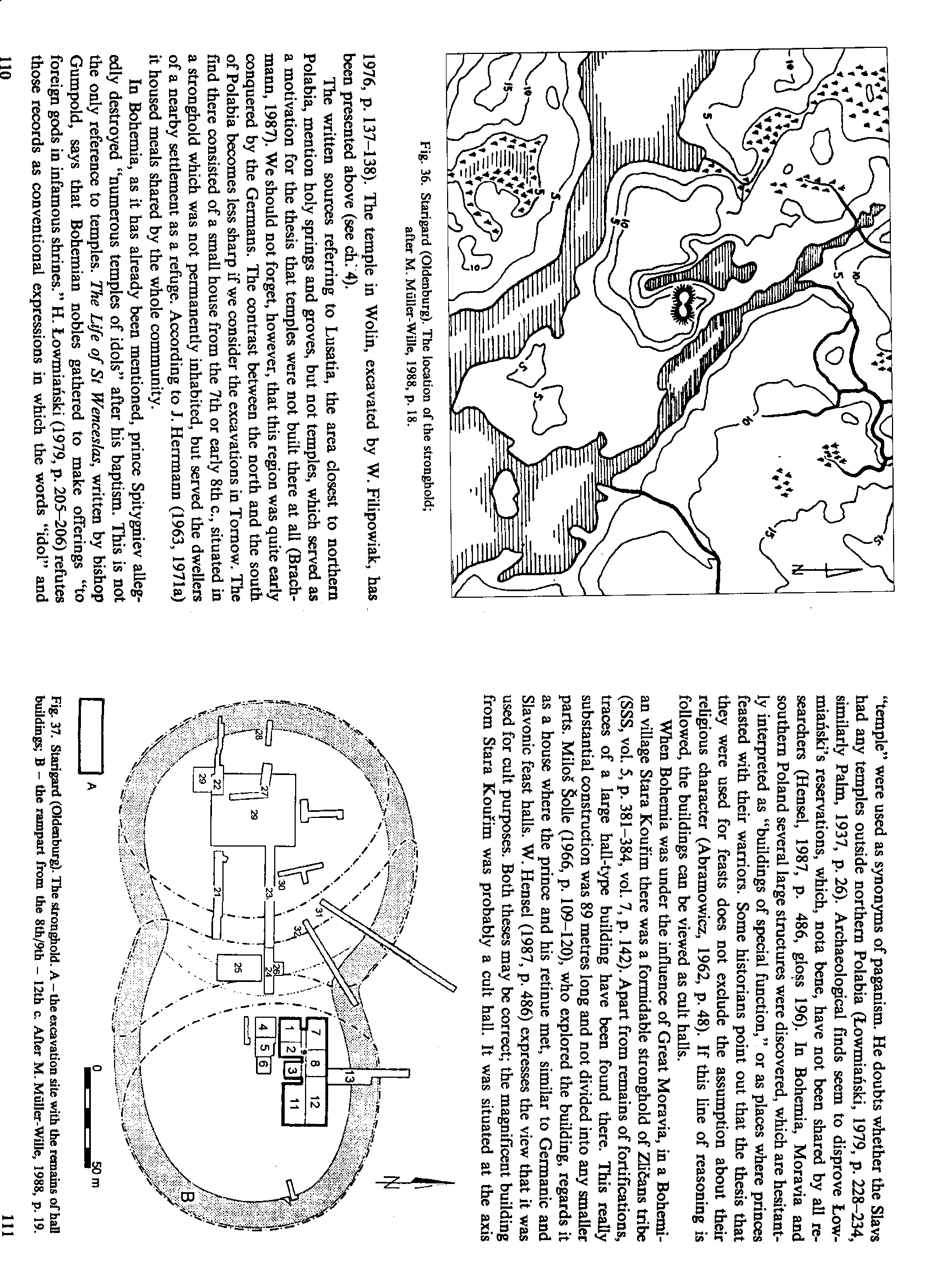image054


Fig. 36. Starigard (Oldenburg). The location of the stronghold; after M. Muller-Wille, 1988, p. 18.
1976, p. 137-138). The tempie in Wolin, excavated by W. Filipowiak, has been presented above (see di' 4).
The written sources referring to Lusatia, the area closest to northem Polabia, mention holy springs and groves, but not temples, which served as a motivation for the thesis that temples were not built there at all (Brach-mann, 1987). We should not forget, however, that this region was quite early conąuered by the Germans. The contrast between the north and the south of Polabia becomes less sharp if \ye consider the excavations in Tomow. The fmd there consisted of a smali house from the 7th or early 8th c., situated in a stronghold which was not permanently inhabited, but served the dwellers of a nearby settlement as a refuge. According to J. Herrmann (1963, 1971a) it housed meals shared by the whole community.
In Bohemia, as it has already been mentioned, prince Spitygniev alleg-edly destroyed “numerous temples of idols” after his baptism. This is not the only reference to temples. The Life of St Wenceslas, written by bishop Gumpold, says that Bohemian nobles gathered to make offerings “to foreign gods in infamous shrines.” H. Łowmiański (1979, p. 205-206) refutes those records as conventional expressions in which the words “idol” and “tempie” were used as synonyms of paganism. He doubts whether the Slavs had any temples outside northem Polabia (Łowmiański, 1979, p. 228-234, similarly Palm, 1937, p. 26). Archaeological finds seem to disprove Łow-miański’s reservations, which, nota bene, have not been shared by all re-searchers (Hensel, 1987, p. 486, gloss 196). In Bohemia, Moravia and Southern Poland several large structures were discovered, which are hesitant-ly interpreted as “buildings of special function,” or as places where princes feasted with their warriors. Some historians point out that the thesis that they were used for feasts does not exclude the assumption about their religious character (Abramowicz, 1962, p. 48). If this linę of reasoning is followed, the buildings can be viewed as cult halls.
When Bohemia was under the influence of Great Moravia, in a Bohemi-an village Stara Kourim there was a formidable stronghold of Zlićans tribe (SSS, vol. 5, p. 381-384, vol. 7, p. 142). Apart from remains of fortifications, traces of a large hail-type building have been found there. This really substantial construction was 89 metres long and not divided into any smaller parts. Milos Solle (1966, p. 109-120), who explored the building, regards it as a house where the prince and his retinue met, similar to Germanie and Slavonic feast halls. W. Hensel (1987, p. 486) expresses the view that it was used for cult purposes. Both theses may be correct; the magnificent building from Stara Kourim was probably a cult hall. It was situated at the axis

Fig. 37. Starigard (Oldenburg). The stronghold. A - the excavation site with the remains of hall buildings; B - the rampart from the 8th/9th - 12th c. After M. Muller-Wille, 1988, p. 19.
111
Wyszukiwarka
Podobne podstrony:
image055 Fig. 39. Starigard (Oldenburg). The sanctuary erected after the destruction of the church i
image023 Fig. 15. Korzenica-Garz. I, II, m - the alleged traces of temples in the stronghold; after
image048 Fig. 24. Gross Raden. A graphic reconstruction of the settlement in phase A (9th century);
Slajd50 1 Akademia medycyny i piękna o*IPL- zmiany naczyniowe Fig. 6 A Spider nevus at the nose. B A
image042 Fig. 18. The topography of the early-raedjevaj Wolin. A - the presumed location of the temp
image047 Fig. 22. The location of the stronghold in Gross Raden. 1 - the stronghold in Gross Grónow;
image038 a Fig 10 Idea of the “World tree" as the “World axis" implemented m settlements o
image083 Fig. 67. The enthroning ceremony of a Carinthian prince on an engraving from Osłerreichisch
image089 Fig- 71. The stoi»e walls around the peak of Góra Dobrzeszowska. 1 - the internal wali; 2 -
image090 Fig. 73. The alleged sanctuary on Bogit mountain. The stronghold. The cult circle. The alle
image100 Psrdwln Fig. 79. The location of Triglav’s sanctuary in Brandenburg-Brenna on Triglav’s Hil
image104 Fig. 86. Jankowo. a: The location (after W. Hensel, 1953, p. 188). b: A wooden sculpture of
image007 Fig. 3. Old Uppsala. Alteged traces of the tempie under the church foundations; from F. Oel
image008 Fig. 4. Possible reconstructions of the tempie in Old Uppsala, drawings based cm: A.-C. Sch
image017 Fig. 10. The plan of the stronghold m Arcona reconstructed by H.Berlekamp and J.Herrmann. A
image049 1 m Fig. 26. The profile and plan of the remains of Ihe south-ea&tem wali base of the t
image056 Fig. 40. Stara Kourim. A large hall building. A - a plan; B - a profile of the wali constru
więcej podobnych podstron